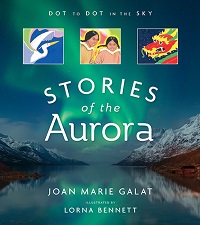| ________________
CM . . .
. Volume XXIII Number 15. . . .December 16, 2017
excerpt:
Joan Marie Galat explains the mysterious lights of the aurora in Stories of the Aurora. This is the fifth volume of the “Dot to Dot in the Sky” series which includes books on astronomy-related topics such as the stars, the planets, the moon and the zodiac. Galat begins the book with a description of the “mysterious lights” which are known as the aurora. She explains the science of these lights in a discussion of Earth’s magnetic field and the Sun’s impact on this magnetic field. Galat is skilled at simplifying very complex scientific concepts for younger readers. Numerous countries throughout the world have folklore associated with the appearance of the aurora. “Legends associated with auroras often describe majestic creatures existing both on Earth and above.” (p. 17) Finland and Estonia tell stories of sea monsters. The people of ancient Greenland describe the aurora as a glacier god whose power can only be seen in the evening hours. Other examples of folklore include stories told by the Alaskan Inuit, the people of Norway, China, and Latvia. Klondike gold prospectors believed that these northern lights were an indicator of gold deposits! At times, Dot to Dot in the Sky is very dense with scientific information. Text boxes address important issues such as: “Earth’s Magnetic Field”, “Other Names for the Aurora” and “Auroral Height and Color”. The illustrations and photographs of the aurora reflect the beauty that is the experience of seeing the lights in the evening sky and complement the text. There are several chapters which address the myths of various cultures regarding the aurora. These myths include cultures as diverse as: the Norse, the Greeks, Wabanaki/Algonquin tribes and Mi’kmaq tribes. Stories of the Aurora is a good source for students doing research on the topic of auroras. It is detailed and beautifully illustrated. Although some of the myths may be a bit dense and detailed, the book provides good background material on an interesting topic related to astronomy. There is also good glossary of terms at the end of this book as well as information about the writer and illustrator. Galat combines mythology and science in this interesting text: “Science helps us understand the physical aspects of what’s happening in the sky, but ancient stories still have a place.” (p. 62) Recommended. Myra Junyk, a literacy advocate and author, lives in Toronto, ON.
To comment
on this title or this review, send mail to cm@umanitoba.ca.
Copyright © the Manitoba Library Association. Reproduction for personal
use is permitted only if this copyright notice is maintained. Any
other reproduction is prohibited without permission.
Next Review | Table of Contents For This Issue - December 16, 2016 |
